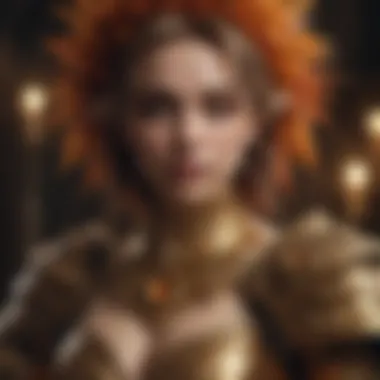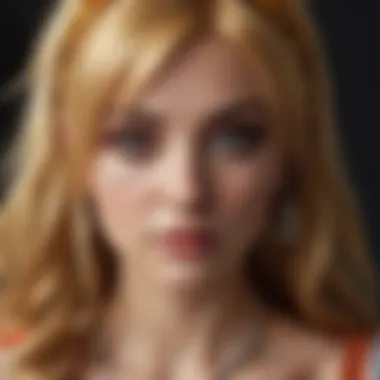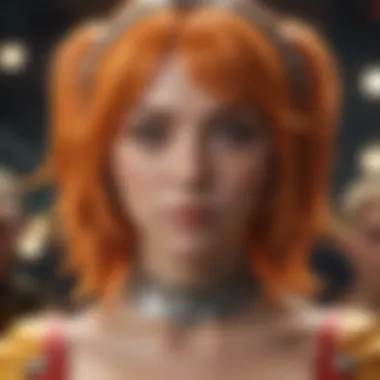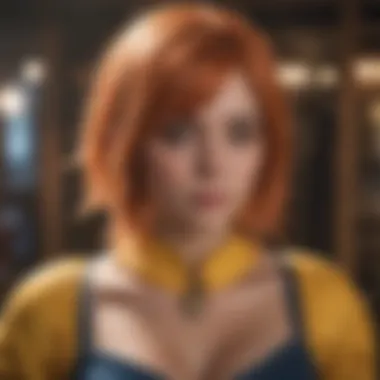Cosplay and the Seven Deadly Sins: An In-Depth Exploration


Intro
Cosplay has become a significant aspect of modern pop culture, transcending the realm of simple fan expression. It is a vibrant art form that invites creativity, craftsmanship, and a keen understanding of character. In particular, the anime series The Seven Deadly Sins has captured the imagination of many, inspiring fans to bring its characters to life through detailed costume design and embodying their traits through performance.
This exploration will analyze the complex relationship between cosplay and The Seven Deadly Sins. The article aims to showcase the character design inspirations taken from the anime, the technical skills needed for costume creation, and the underlying cultural significance of these characters. Furthermore, the dialogue surrounding the evolution of cosplay as an expressive medium will be addressed, offering practical advice for aspiring cosplayers. At its core, this piece seeks to provide insight into the thematic elements represented by each sin and how they manifest in the world of cosplay.
By delving into these aspects, readers will gain a comprehensive understanding of not only the intricate art of cosplay but also how The Seven Deadly Sins contributes to and reflects broader trends within pop culture.
Prelude to Cosplay
Cosplay stands at the intersection of fandom and craftsmanship. It allows individuals to engage deeply with their favorite characters and narratives, promoting a unique form of expression and community bonding. The significance of cosplay within the context of The Seven Deadly Sins is multifaceted. Not only does it celebrate the artistry of character design, but it also fosters a dialogue surrounding the themes presented in the anime.
Engaging in cosplay can be a means for fans to embody the essence of the characters they admire. It helps in understanding the narrative and emotional undertones of the series. As the vast universe of anime unfolds, fans often find themselves drawn to specific traits of the characters that resonate with their personalities. This connection elevates the importance of cosplay as an engaging activity.
In this exploration, we will delve into how cosplay serves as a cultural commentary. It reflects broader societal trends and personal journeys of individuals within the community. Furthermore, understanding cosplay's roots can give us insight into its evolution, leading to discussions on how cosplay engages with modern pop culture.
Understanding Cosplay
Cosplay combines the words "costume" and "play". It is more than just wearing a costume; it represents a complete immersion into the persona of a character. The practice enables fans to showcase their creativity and dedication. Character portrayal often extends beyond mere visuals, emphasizing embodying that character's attitudes and traits.
Key aspects of cosplay include:
- Costume Design: A core element reflects the personality and nuances of the chosen character.
- Performance: Many cosplayers engage in skits or performances that bring the character to life.
- Craftsmanship: Skills such as sewing, prop making, and wig styling are often essential to create an authentic look.
Understanding these components is critical. Cosplay acts as a bridge connecting fans with the narrative and artistry of series like The Seven Deadly Sins.
The Origins of Cosplay
The roots of cosplay can be traced back to the early days of fan conventions. While similar practices existed around the world, cosplay as it is known today began to take shape in the 1980s. The term was first coined by Nobuyuki Takahashi at a science fiction convention in Los Angeles.
Initially, cosplay was more closely associated with science fiction and fantasy genres. However, as anime and manga gained popularity in the West, the concept expanded to include characters from these media. The Seven Deadly Sins, with its complex characters and rich story arcs, provides fertile ground for cosplay.
As the culture around cosplay matured, so did the techniques and resources available to aspiring cosplayers. Today, individuals can find tutorials, forums, and communities online, making cosplay more accessible than ever.
Overview of The Seven Deadly Sins
The Seven Deadly Sins, a popular anime and manga series, serves as a rich backdrop for the exploration of cosplay. The narrative revolves around a group of knights, each embodying one of the seven deadly sins. This connection between character traits and sin creates unique personas that cosplayers can interpret. Understanding these characters is critical, as it gives depth to the costumes cosplayers choose to create.
Cosplay inspired by these characters not only showcases the art of costume design but also delves into the themes of morality and human flaw. Characters such as Meliodas and Diane represent extremes of feelings, allowing cosplayers to express their own interpretations of wrath and envy, respectively. This adds a layer of personal connection to the costumes, enabling a more engaging experience in both creation and presentation.
Plot Summary and Characters
The plot of The Seven Deadly Sins follows the journey of a disbanded group of knights who are on a quest to save their kingdom. Each character has a distinct trait associated with their respective sin, influencing their motivations and actions. For example, Meliodas, the leader, is characterized by his overpowering wrath, while Ban's greed drives much of his personal quests.
Several key characters are pivotal to the series:
- Meliodas: The Dragon's Sin of Wrath, embodying anger and a fierce protective instinct.
- Diane: The Serpent's Sin of Envy, struggling with feeling inferior and fighting for recognition.
- Ban: Known as the Fox's Sin of Greed, seeking eternal life and riches.
- Gowther: The Goat's Sin of Lust, representing manipulation and desire.
- Merlin: The Boar's Sin of Gluttony, symbolizing insatiable hunger for knowledge.
- Escanor: The Lion's Sin of Pride, reflecting unmatched self-confidence and might.
- King: The Grizzly's Sin of Sloth, torn between his duties and personal desires.
These characters offer plenty of inspiration for cosplayers, showcasing a range of personalities and emotional depth. Their influence extends beyond the screen, resonating deeply with fans.
Cultural Impact and Reception


The Seven Deadly Sins has made a significant mark in both anime and wider pop culture. Its portrayal of complex characters dealing with personal and moral dilemmas has garnered substantial attention. The balance between humor and serious themes provides an engaging narrative that resonates with many.
Reception has been largely positive, building a strong community. Fans often connect over the themes presented in the series. Cosplay events frequently feature these characters, showcasing the craftsmanship of fans. The characters' design also sparks discussions about what each sin represents in real life.
The series has not only entertained but has also inspired a wave of creativity within the cosplay community. By embodying these characters, cosplayers participate in a larger conversation about identity and expression. This dynamic fosters a sense of belonging and shared understanding among enthusiasts.
"Cosplay allows us to breathe life into our favorite characters, exploring their stories and sins while interpreting them through our own lens."
The Seven Deadly Sins Characters
The characters in The Seven Deadly Sins hold significant importance not just within the anime and manga, but also in the cosplay community. Each character embodies a unique sin, layered motivations, and distinct designs that cosplayers can interpret and recreate. These characters foster a deep connection with fans who resonate with their struggles, backgrounds, and personalities.
By exploring these characters, cosplayers are able to take part in a larger narrative that emphasizes themes like redemption, friendship, and the battle between good and evil. The way each character is designed serves as a blueprint for cosplayers, offering inspiration in both costume creation and performance.
Meliodas: The Dragon's Sin of Wrath
Meliodas, as the leader of the Seven Deadly Sins, is a powerful character whose design combines charm and ferocity. With spiky blonde hair and a distinct jacket, he serves as an archetype of the rebellious hero. His character arc, filled with frustration and rage connected to his past, sets a tone for the themes of wrath and redemption. Cosplayers often pay close attention to his signature sword and the details of his attire to accurately portray his complex persona.
Diane: The Serpent's Sin of Envy
Diane is unique for her stature and strength; as a large warrior, she embodies the sin of envy through her feelings of inadequacy compared to others, especially toward her companions. Her rock-themed powers and earth-related abilities reflect her connection to nature. In cosplay, her flowing clothing and distinct accessories, like her giant weapon Gideon, are essential. Many look to capture her essence by showcasing both her powerful and vulnerable sides in their performance.
Ban: The Fox's Sin of Greed
Ban's character is defined by layers of complexity and a morally grey nature. Known for his immortality and mischievous attitude, he represents greed but also showcases a deep loyalty to his friends. His aesthetics, like his rugged clothing and signature long hair, provide cosplayers with opportunities to express a range of emotional depth. The challenge lies in balancing his outward confidence with his tragic backstory, which adds an essential dimension to any cosplay.
Gowther: The Goat's Sin of Lust
Gowther, with an ambiguous background, presents unique challenges for cosplayers. Their character oscillates between emotional detachment and a desire to understand human feelings. The distinctive outfit, complete with a heart-shaped mask, becomes integral in expressing this duality. Cosplayers often emphasize their magical abilities in performances to showcase Gowther's complexity and vulnerability.
Merlin: The Boar's Sin of Gluttony
Merlin is a character that thrives on intelligence and mystique. As the group's sorceress, her attire combines elegance with power, featuring intricate patterns and a deep color palette. Cosplayers appreciate the intricacies of her character, particularly her magical prowess and her nonchalant demeanor. Creating the elements of her spells using props can greatly enhance the overall portrayal in cosplay.
Escanor: The Lion's Sin of Pride
Escanor perfectly illustrates the evolution of a character through his contrasting appearances linked to his strength. As the self-proclaimed strongest man, he boasts a unique and flamboyant outfit. Cosplayers often find Escanor's transformation between meekness and boldness appealing. Accurately portraying this requires a blend of confidence and refinement in performance.
King: The Grizzly's Sin of Sloth
King, embodying sloth, presents a softer side among the Seven Deadly Sins, marked by introspection and compassion. His character focuses on themes of leadership despite his laid-back attitude. His design includes distinct natural motifs, which are crucial for cosplayers striving to reflect his gentle yet strong persona. Costumes emphasizing his fairy heritage can enhance the portrayal while engaging audiences in the character's internal conflict.
As fans of pop culture dive deeper into these characters, the connections forged through cosplay enrich both individual experiences and community engagement.
Character Design in Cosplay
Character design is a foundational element in cosplay and plays a critical role in bridging the gap between fans and the characters they admire. In the context of The Seven Deadly Sins, character design is vital as it not only dictates how a cosplayer embodies the chosen character but also translates the essence of their narrative into a tangible representation. Good character design captures the visual identity and emotional depth, allowing cosplayers to evoke the spirit of the character accurately. This is important for several reasons, including the enhancement of the overall cosplay experience and creating a stronger connection with the audience.
When cosplayers engage in character design, they must consider a variety of aspects: the original anime art style, the color palette, specific costume elements, and the personality traits embodied by the character. These elements contribute to the effectiveness of the costume, as they help communicate the character's story and their role within The Seven Deadly Sins. Effective character design allows cosplayers to showcase their crafting skills while emphasizing the narrative significance of their chosen figure.
Analyzing Character Design
Analyzing character design involves breaking down various components of a character's appearance. For The Seven Deadly Sins, this may include examining Meliodas's signature hairstyle and clothing, or Diane's armor and stature. Each design choice tells the viewer something about the character's role and personality. For instance, Meliodas's casual attire contrasts with his fierce combat abilities, illustrating complexity.


Key elements to analyze include:
- Color Schemes: The use of colors can dictate emotions connected to a character. Dark tones may represent secrecy or sadness, whereas vibrant hues can indicate joy or liveliness.
- Silhouette: The overall shape or outline of the character is important in conveying their stature or personality. A strong, imposing figure often signifies strength, while a more delicate silhouette may represent vulnerability.
- Symbolism: Many characters include symbolic elements in their design. For example, Escanor’s sun-themed attire conveys his connection to light and pride.
By thoroughly analyzing these elements, cosplayers can make informed choices in their costume creation, better embodying the character and enhancing the audience's experience.
Elements of Costume Creation
Costume creation is an art in itself, requiring attention to detail and a deep understanding of the character. When creating costumes inspired by The Seven Deadly Sins, cosplayers need to focus on certain core elements:
- Fabric Selection: The choice of material affects the overall look and feel. Options may range from silk for a more flowy effect, to sturdy canvas for armor-like designs.
- Construction Techniques: Skills such as sewing, drafting patterns, and fitting garments are essential. Each technique contributes to the costume's accuracy and durability.
- Accessories and Props: This includes not only clothing but also items that define the character, like Ban's flask or Merlin's grimoire. These accessories enrich the portrayal and add authenticity.
Creating an effective costume often entails trial and error. It is important to review reference images from different angles to capture nuances.
"Cosplay is not just about making costumes; it is an expression of affection toward the characters and their stories."
Combining these elements effectively transforms cloth and thread into a vivid homage to the beloved characters from The Seven Deadly Sins, allowing cosplayers to emerge not just as impersonators but as storytellers in their own right.
Techniques for Effective Cosplay
Cosplay is not just about wearing a costume; it is an immersive art form that requires skill, creativity, and attention to detail. Understanding the techniques for effective cosplay is crucial for transforming into characters from beloved series like The Seven Deadly Sins. This section will cover essential skills such as sewing, prop making, and how to use makeup and wigs to enhance the overall look. Each of these components plays a vital role in achieving authentic character portrayal, as well as adding personal flair to a design.
Sewing and Fabric Selection
Sewing is the backbone of character costumes. Selecting the right fabric is important for both appearance and comfort. Different characters from The Seven Deadly Sins have distinct clothing styles, which necessitate various fabric types. For instance:
- Cotton: Light and breathable, ideal for casual looks, suitable for characters like Meliodas.
- Velvet: Adds richness, perfect for royal characters like Escanor.
- Spandex: Often needed for more fitted costumes, especially for dynamic characters like Diane.
When sewing, pay attention to the pattern lines and the scale of the character's wardrobe. It is equally important to construct pieces that allow for movement and flexibility. Many cosplayers use patterns from commercial companies or DIY their own templates based on character references.
Prop Making Essentials
Props are the finishing touches that can elevate a cosplay significantly. They help in achieving authenticity by representing key elements of a character's identity. For characters like Ban and Gowther, props can include custom weapons or unique accessories.
To create effective props, consider these tips:
- Materials: Foam, wood, and thermoplastics are popular choices. Foam is lightweight and easy to shape, while thermoplastics provide durability.
- Techniques: Techniques such as carving, sculpting, and painting are essential. Use craft knives for precision and heat guns to mold thermoplastics.
- Finishing Touches: Painting and detailing bring props to life. Invest time in getting the color schemes right, as this enhances the overall visual impact.
Utilizing online tutorials and community resources can greatly aid in prop making; platforms like reddit.com often have dedicated sections for sharing techniques.
Makeup and Wigs
Makeup and wigs can dramatically alter one’s appearance, making them essential tools for cosplayers. Makeup is not only about applying colors; it also involves techniques for creating age, character traits, and even supernatural effects. Here are some considerations:
- Foundation: Choose according to your character's skin tone. Test in natural light for accuracy.
- Special Effects: Products like face paint and prosthetics can help recreate more dramatic features seen in The Seven Deadly Sins
Wigs, on the other hand, need careful selection regarding style and color. Consider these aspects when selecting a wig:
- Style: Characters may have unique hairstyles, which necessitate wigs with specific cuts and volumes. For instance, the spiky hair of Meliodas or the long locks of Diane.
- Color: Always match wig colors to reference images. Some characters may require gradient or unusual colors.
- Application: Learn how to properly secure wigs for long wear. Using wig caps and adhesives can ensure that wigs stay in place during conventions or events.
End
By mastering sewing, prop making, and makeup application, cosplayers can achieve not just a costume, but a transformation into a beloved character from The Seven Deadly Sins. The techniques discussed here serve as a guideline and inspire creativity, allowing cosplayers to explore and express their interpretations while connecting with a vibrant community. However, the process of creating a cosplay should remain enjoyable and reflective of one's personal style.


Cosplay Communities and Events
Cosplay communities and events serve as crucial hubs for enthusiasts to connect, share experiences, and showcase their passion for cosplay. These gatherings provide cosplayers an opportunity to interact in person, exchange ideas, and refine their costumes through collaboration. The significance of these communities extends beyond mere socialization; they act as platforms for learning, creativity, and inspiration. In the context of The Seven Deadly Sins, these interactions can deeply enhance one's understanding of character nuances and thematic expressions, fostering a richer connection to the material.
Conventions and Competitions
Conventions often feature competitions that celebrate the artistry and effort cosplayers put into their costumes. Events like Anime Expo or Comic-Con host gatherings where aspiring and seasoned cosplayers can enter competitions, showcasing their interpretations of characters from The Seven Deadly Sins. Each contestant prepares their outfit meticulously, often driven by a desire to impress judges and peers alike.
These competitions often prompt participants to embody the character’s traits, thus enhancing their connection to both the character and the series. Furthermore, participating in these events can lead to publicly recognized achievements, bolstering one's confidence and encouraging further exploration of cosplay.
The energy found at conventions is unmatched. That's where the true spirit of cosplay comes to life.
Online Communities and Resources
In addition to physical events, online communities provide expansive networks for cosplayers. Websites like Reddit and Facebook offer groups where people can share tips, post progress shots, and seek advice. Online platforms are invaluable due to their accessibility, allowing individuals from varied backgrounds to participate regardless of geographical location.
Engaging with these virtual communities enables cosplayers to share tutorials on sewing techniques, makeup artistry, and prop-making essentials tailored for The Seven Deadly Sins. Resources like YouTube tutorials or cosplay websites can guide beginners through the intricacies of costume construction or performance aspects.
In summary, both conventions and online communities significantly influence the cosplay culture surrounding The Seven Deadly Sins. They create spaces for growth, learning, and camaraderie. As such, they are integral not only to the individual journey of cosplayers but also to the broader tapestry of the cosplay phenomenon.
Thematic Elements of The Seven Deadly Sins
The thematic elements of The Seven Deadly Sins encapsulate the essence of human flaws and moral challenges. These elements play a vital role in the anime and manga series, serving as a framework for character development and narrative progression. Each sin represents a distinct aspect of human nature, prompting reflections on virtue and vice. Understanding these themes is essential for cosplayers as it allows them to connect with their chosen characters on a deeper level.
In this context, cosplaying characters such as Meliodas or Diane goes beyond mere imitation. It transforms into a representation of complex emotions and conflicts. By embracing the thematic elements, cosplayers can convey the underlying messages of the series, making their portrayals more impactful and resonant with audiences.
Exploring the Seven Sins
Each sin in the series—Wrath, Envy, Greed, Lust, Gluttony, Pride, and Sloth—holds significant meaning.
- Meliodas, the Dragon's Sin of Wrath, embodies anger but also showcases redemption through his love and responsibility for his friends. His character highlights the battle between rage and the need for compassion.
- Diane, the Serpent's Sin of Envy, represents jealousy but also the journey of self-acceptance, making her arc relatable to many.
The exploration of these characters allows cosplayers to not just dress up but to express multifaceted parts of humanity. When someone chooses to cosplay as Ban, they engage with themes of guilt and atonement. Each character's journey embodies lessons that can resonate with audiences on personal and societal levels.
Moral Implications and Reflections
The moral implications within The Seven Deadly Sins extend beyond the narrative, prompting reflections in real life. The interplay of each sin elaborates on the thin line between virtue and vice. For instance, while greed may lead to destruction, it can also motivate individuals to strive for better opportunities. This duality creates an interesting platform for discussion among fans and cosplayers.
When cosplayers enact these characters, they open up dialogues about the struggles of morality. It allows for introspection, as they consider which sins resonate with their life experiences.
The simple act of embodying a character becomes a vehicle for exploring complex ethical questions and personal growth.
Epilogue
The conclusion of this article encapsulates the intricate bond between cosplay and the thematic elements presented in The Seven Deadly Sins. This connection goes beyond mere aesthetics and delves into the deeper implications surrounding character portrayal and audience engagement.
Future of Cosplay
The future of cosplay promises to be dynamic and evolving. As technology advances, so too will the methods of costume creation and character representation. 3D printing and digital fabrication offer new avenues for intricate designs, which can be tailored to reflect the complexities of characters from The Seven Deadly Sins. Additionally, virtual reality and augmented reality might reshape how cosplayers present themselves at events or online.
Moreover, the increasing popularity of anime and manga globally leads to a larger, more diverse cosplay community. More conventions are emerging worldwide, offering fans and cosplayers a platform to express themselves, share knowledge, and celebrate their love for characters. Events like the Anime Expo and Comic-Con now draw thousands of enthusiasts, showcasing creativity and craftsmanship.
Impacts of social media cannot be overlooked. Platforms such as Instagram, Pinterest, and Reddit provide spaces for cosplayers to share their work, exchange tips, and connect with others who share similar interests. It is likely that these online platforms will continue to play a pivotal role in shaping trends and fostering community connections.
As we look ahead, aspiring cosplayers would benefit from engaging with these resources and participating in both local and international events. The journey in cosplay is not merely about the finished product but rather about the learning, growth, and camaraderie shared within the community.
"Cosplay is not just an art form; it's a way to live the stories we love and connect with others who feel the same."
In summary, the intersection of cosplay and The Seven Deadly Sins serves as a fertile ground for creativity and self-expression. The ongoing evolution of both the cosplay culture and the series itself ensures that this realm will remain vibrant and engaging for many years to come.



